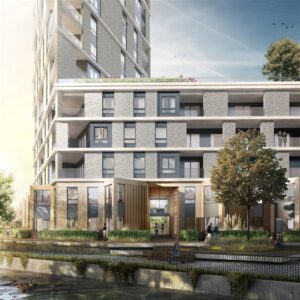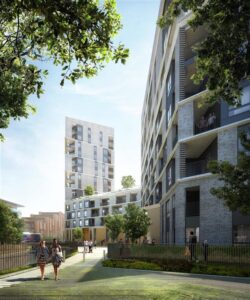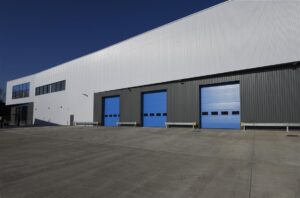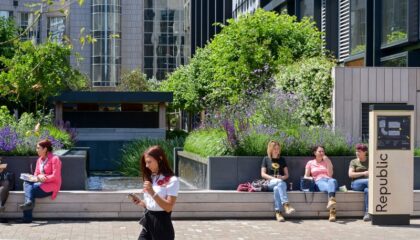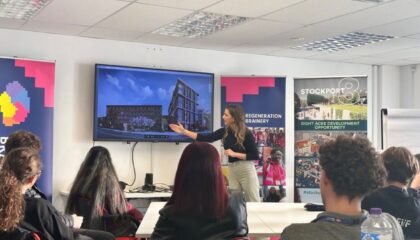Workman’s ESG Project Advisor function delivers precisely the knowledge that clients and project teams require to ensure that their ESG strategies are on track, and achieve a positive commercial impact, but how does it work and what difference does it make?
Hedley Jones, Partner and Head of ESG Refurbishment and Development, explains.
The Workman ESG Project Advisor team is currently applying its expertise on a broad scope of refurbishment and development projects with a collective value in excess of £745m, across more than 4.1m sq. ft of office, industrial and residential space.
These include delivering new-build industrial units to Net Zero in construction standards, working on BTR developments to drive carbon reduction, as well as broader ESG targets, and providing strategic advice for office redevelopments.
How does the ESG Project Advisor service work?
Following analysis of all ESG aspects of a project, dashboard-style reporting is used to demonstrate a baseline position, against which a range of targets can be set to enable option studies to be tested. Regular snapshots provide project teams with a barometer of their progress, together with opportunities to secure further improvements.
When involved at the initial project briefing stage, all options can be fully assessed for feasibility, allowing a menu of choices before final design choices are confirmed. This enables the advisor to plot outcomes from a variety of potential scenarios, while ensuring that project ambitions are locked in.
Involvement throughout the project allows key performance metrics to be tracked, helping marketing and leasing activity, as well as providing a clear platform for managing carbon in use during the building’s operation.
What difference does the ESG Project Advisor service make?
Navigating the ESG kaleidoscope: Our broad sphere of technical, sustainability and commercial knowledge allows our experts to stand back from the maze of ESG options and ensure that clients are receiving an independent sense check, free of alignment to any particular product or service provider.
For a recent 165,00 sq. ft. new-build logistics development in Hertford, the Workman project advisor service managed to unpick the growing list of ESG requirements and establish areas of common alignment to help simplify the reporting and unlock key decisions to enable the scope to be refined.
Setting clear targets: By getting the targets right at the outset, knowing what our clients’ base position looks like, and what they’re trying to achieve, we can ensure that goals are clear and achievable. At Axion House, a residential scheme in south-east London (pictured below), which is designed to provide 100% affordable housing across 141 homes, Hestia (the asset managers for the residential operating platform of Federated Hermes) operate a design innovation approach to pushing performance.
Within this framework, our ESG Project Advisor role helped shape targets and specialist reporting to demonstrate performance through the various project stages.
In the majority of cases, these targets are not driven by planning requirements but by funds themselves, who see both the climate benefit and long term commercial value for pushing higher standards.
Delivering smart measurable results: The ESG Project Advisor service often challenges project teams to extend their thinking. At Merton37, a new industrial unit in south-west London built by Harmonix Construction to Net Zero-ready specifications for client Columbia Threadneedle, the ESG Project Advisor pushed the project (pictured below), beyond mandatory standard levels.
The solar PV base position had been planned to cover the statutory requirement. It was then expanded to cover the base-build energy demand, achieving an EPC A plus position. Rainwater collection for landscape irrigation, which had not been included in the original project plan, was added.
Meanwhile, EV charging was future-proofed to provide 100% passive provision with six live charging points. Biodiversity net gain was also increased through a planting scheme incorporating native species, and providing improved habitats for wildlife.
Greater returns and attractive savings: It’s important to note that carbon savings can often be identified without adding financial cost, by reducing the amount of ‘material’ added to a project i.e. not installing suspended ceilings in lieu of an exposed services option. It may be possible to cut embodied carbon emissions from the development simply by harnessing the expertise of our ESG Project Advisor to streamline design and specification and ensure opportunities are taken.
Achieving zero-carbon goals
Investors and occupiers are both striving for more efficient buildings, not only in terms of cost, but also carbon. A marginally higher outlay at the outset of a project can deliver greater returns and attractive savings over a typical lease term. It can also make the building more attractive to occupiers, with the potential to reduce void periods.
Achieving zero-carbon goals is one of the greatest challenges faced by commercial real estate, and indeed the planet. Considering carbon-positive and cost-effective solutions at the outset of a refurbishment or development project will create a more resilient, and more valuable, asset in the longer term. And for refurbishment and development projects to have the most impact, the project team needs ESG expertise on board, from the earliest possible stage.
By Hedley Jones, Head of ESG, Refurbishment and Development
Read more:

